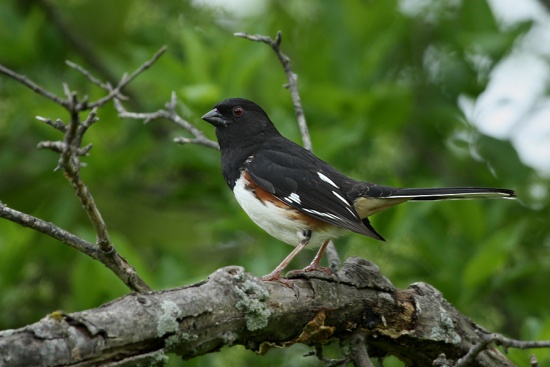- Pipilo erythrophthalmus
Identification
Male
- Rufous sides
- Black upperparts, and breast
- White underparts
- White outer tail feathers are seen in flight
Female
- Brownish upperparts
- Rufous sides
- White underparts
- Similar patterned to male, only black areas are replaced with brown
Juvenile
- Brown with heavy streaking on both upper and underside
Distribution
Eastern United States north to New York and Massachusetts.
Taxonomy
Formerly considered conspecific with the Spotted Towhee as the Rufous-sided Towhee.
Subspecies
There are 4 subspecies[1]:
Eastern Towhee (Red-eyed)
- P. e. erythrophthalmus:
- Eastern North America (southern Canada to Gulf Coast)
- P. e. canaster:
Eastern Towhee (White-eyed)
- P. e. rileyi:
- P. e. alleni:
- Central peninsula Florida to tip of peninsula
Habitat
Deciduous forest and woodland edges, scrub, fields and gardens.
Gallery
Click on image to enlarge
Juvenile
Photo by Fowl Mouth
Connecticut, USA, July 2010
Behaviour
Breeding
They nest in low vegetation or on the ground under shrubs.
Diet
Seedeaters, they readily visit garden feeders.
References
- Clements, J. F., T. S. Schulenberg, M. J. Iliff, B.L. Sullivan, C. L. Wood, and D. Roberson. 2012. The eBird/Clements Checklist of Birds of the World. 6th ed., with updates to October 2012. Ithaca: Cornell Univ. Press. ISBN 978-0801445019. Spreadsheet available at http://www.birds.cornell.edu/clementschecklist/downloadable-clements-checklist
- Wikipedia
- BF Member observations
Recommended Citation
- BirdForum Opus contributors. (2025) Eastern Towhee. In: BirdForum, the forum for wild birds and birding. Retrieved 5 February 2025 from https://www.birdforum.net/opus/Eastern_Towhee
External Links
GSearch checked for 2020 platform.1








